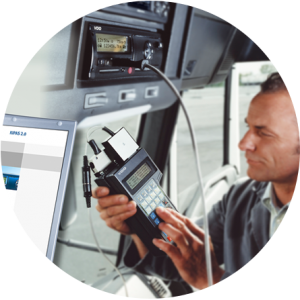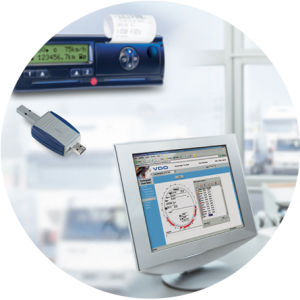Tachograph
Tachographs are units designed to automatically track and record road speed, distance and driver activity over set periods of time. The equipment is fitted in the front cabin of a vehicle so that the user can control its various modes and functions. The data recorded is based on four modes:
Drive Mode
Other Work Mode
Rest Mode
Availability Mode
The main reason why digital tachographs are mandatory in modern vehicles is because they are much more reliable. The data can be secured and managed more easily by authorities with different data card, and the data itself can be easily examined with computer software without any margin for error. We stock a comprehensive range of digital tachographs from Siemens, Stoneridge, Actia and more, as well as digital tachograph printer rolls and data management solutions.
Analogue Tachograph
The recording medium of an analogue tachograph is very different. The main head unit is made of wax coated paper discs that rotate throughout the day, with one disc rotation being used for each 24 hour period. The data is retrieved visually with the help of manual analysis tools and analogue charts, which detect overlapping traces that mark speed and distance.
Analogue tachographs aren’t as common since the new EU regulations came in, but newer analogue modular designs allow the head to be fitted in a standard DIN slot in your vehicle’s dashboard.
Tracking and recording driver speed, distance and activity is a lot harder and more time-consuming than the digital version, with more room for human error. However analogue tachographs make it clear when the start and end points of each day are, and the handwritten information makes it harder for drivers to forge their data.
A History of the Tachograph
The tachograph was first introduced for use on the railroads, so that companies could document activity and identify irregularities. At the time, the device was called the Hasler Event recorder and was invented by Max Maria von Weber in the 1920s. He was a civil servant, engineer and author.
Fast-forward to the 1950’s and tachographs were beginning to get more popular in the automotive industry, as more road accidents were being attributed to sleep-deprived drivers. Safety concerns meant that analogue tachographs were used by commercial vehicle companies to log driving hours and distance, to regulate work and break times. However at this time, tachographs were only voluntary and carried no legislation yet.
Since 1985, tachographs had been made mandatory for all commercial vehicles over 3.5 tonnes. They had proven to be effective at regulating driver activity and improving safety on the roads, making them an indispensable tools for managing vehicle fleets to this day.
Contact us


You must be logged in to post a comment.